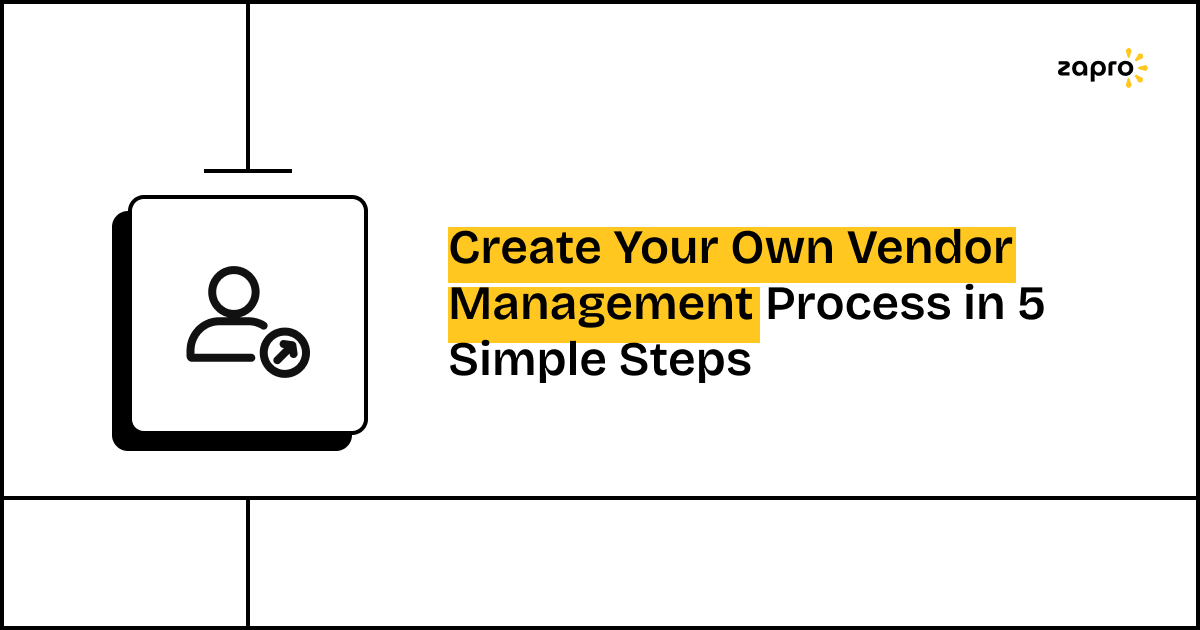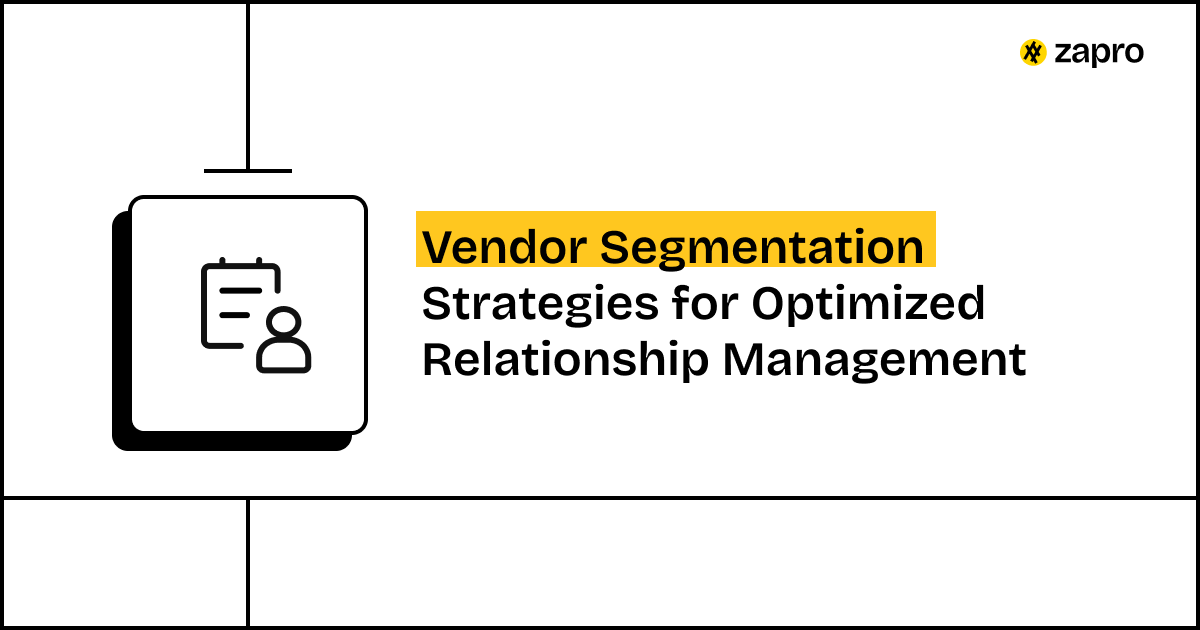You are Here: Vendor Management System >> Vendor Management Process
Every business relies on vendors, whether it’s a logistics partner keeping deliveries on time, an IT provider maintaining your systems, or a supplier delivering the raw materials you need. But simply having vendors isn’t enough. Without a clear process to manage them, costs can spiral, quality can slip, and risks can go unnoticed.
That’s where a structured vendor management process comes in. It helps you choose the right partners, set expectations from day one, and keep performance on track.
In this guide, we’ll walk through five straightforward steps you can follow to create your own vendor management process; one that saves money, reduces headaches, and builds stronger partnerships.
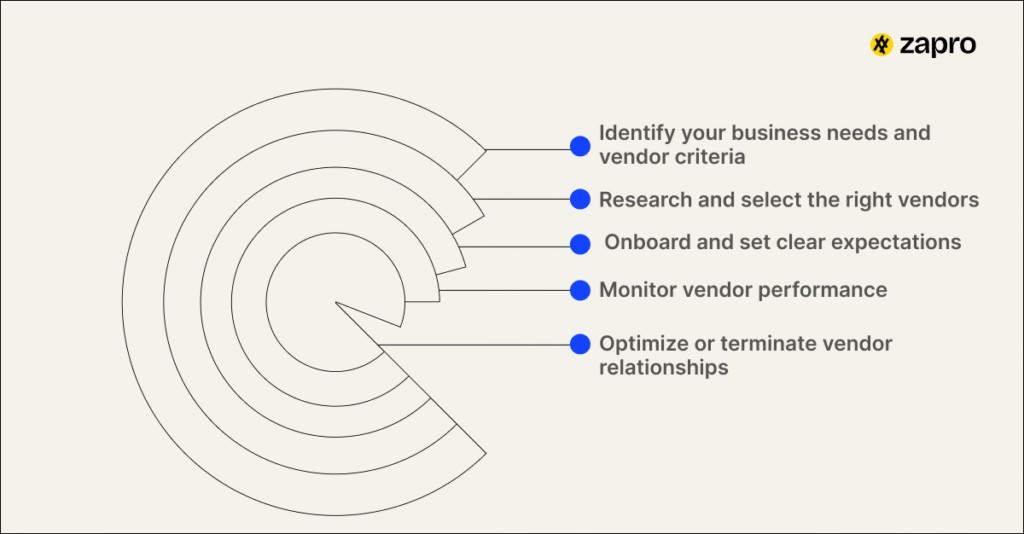
Step 1: Identify your business needs and vendor criteria
Before you start reaching out to potential vendors, you need to be crystal clear about what your business actually needs. Think of this as laying the foundation, without it, the rest of your process can easily go off track.
You can start by mapping out the types of vendors your business relies on. This could include IT service providers, logistics partners, raw material suppliers, marketing agencies, or even temporary staffing companies.
For each type, ask yourself a few key questions:
- What specific products or services do we need?
- How critical are they to our day-to-day operations?
- What would happen if the vendor failed to deliver?
Once you’ve got those answers, define your selection criteria. This might include budget limits, compliance requirements, industry experience, location, or the ability to scale with your business.
For example, a manufacturing company might prioritize vendors who can meet strict safety regulations, while a growing e-commerce brand might focus on suppliers who can handle seasonal demand spikes.
The clearer your criteria, the easier it becomes to spot the vendors who are a great fit, and filter out the ones who aren’t.
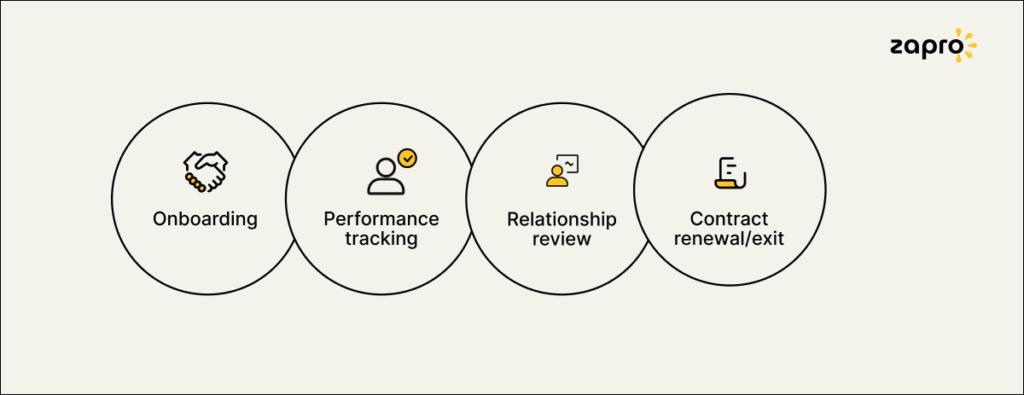
Step 2: Research and select the right vendors
Once you know what you’re looking for, the next step is to find vendors who meet your needs and compare them side by side before making a choice.
Here’s how to approach it:
- Search in multiple places
- Ask for referrals from trusted contacts in your industry.
- Check online directories and vendor marketplaces.
- Attend trade shows or networking events.
- Issue a Request for Proposal (RFP) for more complex needs.
- Evaluate using clear criteria
- Create a scorecard to rate each vendor on pricing, certifications, experience, flexibility, and location.
- Arrange demos, proposal presentations, or site visits to see how they operate in practice.
- Negotiate and verify
- Be upfront about your expectations, timelines, and budget.
- Stay open to creative proposals that could bring extra value.
- Check references and confirm credentials before signing.
Spending extra time here pays off.
Because, the wrong vendor can cost you more in delays, rework, or compliance issues than you might expect. The right one becomes a partner you can rely on.
Step 3: Onboard and set clear expectations
Once you’ve chosen your vendor, the onboarding phase sets the tone for your entire working relationship. This is where you align processes, share critical information, and make sure both sides know exactly what’s expected.
- Complete the essentials
- Gather all required documents: contracts, tax forms, compliance certificates.
- Set up access to your systems, tools, and communication channels.
- Share key contact details for both day-to-day and escalation purposes.
- Agree on how you’ll communicate
- Decide on preferred communication channels (email, project management tools, video calls).
- Set response time expectations for questions or issues.
- Schedule regular check-ins to review progress.
- Define KPIs and SLAs
- Establish clear performance metrics like delivery times, quality scores, and cost efficiency.
- Document service level agreements so expectations are measurable and enforceable.
- Align on compliance and regulations
- Review industry-specific requirements (e.g., data privacy laws, safety standards).
- Ensure the vendor understands and can meet these obligations.
A thorough onboarding process reduces misunderstandings, builds trust early, and creates a solid framework for accountability.
Most people skip this step often leading to missed deadlines and finger-pointing later. Don’t be that person.
Step 4: Monitor vendor performance
Signing the contract isn’t the end of the process, it’s the start of ongoing performance management. Regular monitoring keeps vendors accountable and ensures the quality you agreed on is actually delivered.
- Track performance with the right metrics
- Delivery times and order accuracy
- Product or service quality scores
- Cost efficiency compared to budget
- Responsiveness to issues or change requests
- Use tools to simplify tracking
- Vendor management systems with built-in dashboards
- Shared project management platforms for real-time updates
- Automated alerts for missed deadlines or KPI dips
- Review regularly
- Schedule monthly or quarterly performance reviews
- Share reports ahead of time so discussions are focused
- Highlight both strengths and areas needing improvement
- Close the feedback loop
- Give clear, actionable feedback to vendors
- Agree on corrective actions and timelines for improvement
- Document all performance conversations for reference
Consistent monitoring isn’t about micromanaging, rather it’s about protecting your business and making sure your vendors are truly delivering value.

Vendor management no longer represents a contracting function in procurement; rather, firms have plans to create full supplier relationship life-cycle governance capabilities.
Step 5: Optimize or terminate vendor relationships
See, vendor relationships have to be handled with care and they shouldn’t run on autopilot forever.
Over time, you’ll have to decide whether to strengthen, renegotiate, or end them, purely based on how they’re performing and what your business needs right now.
- Look for ways to optimize
- Renegotiate terms if your order volume has grown or if market conditions have shifted in your favor.
- Consolidate similar services under fewer vendors to simplify management and improve pricing.
- Explore new tech, tools, or processes your vendors can adopt to make things more efficient.
- Know when to walk away
- Consistent underperformance despite multiple chances to improve
- Compliance breaches or repeated missed deadlines
- Rising costs without clear added value
- Plan the exit carefully
- Review termination clauses so you follow the right notice periods.
- Collect all data, assets, and documentation before parting ways.
- Line up a replacement vendor in advance to avoid service gaps.
- Keep improving your process
- Use the lessons learned to refine your vendor selection criteria.
- Share those learnings with your team so they can avoid the same pitfalls.
Strong vendor management is about being proactive, like rewarding great performance, improving what’s not working, and not hesitating to move on when the partnership is no longer serving your goals.
Common challenges in vendor management and how can you overcome them?
Even with a well-structured vendor management process, certain pitfalls can undermine performance, compliance, and cost efficiency.
Recognizing these issues early is the key. Through which you can build safeguards into your process and ensure long-term success.
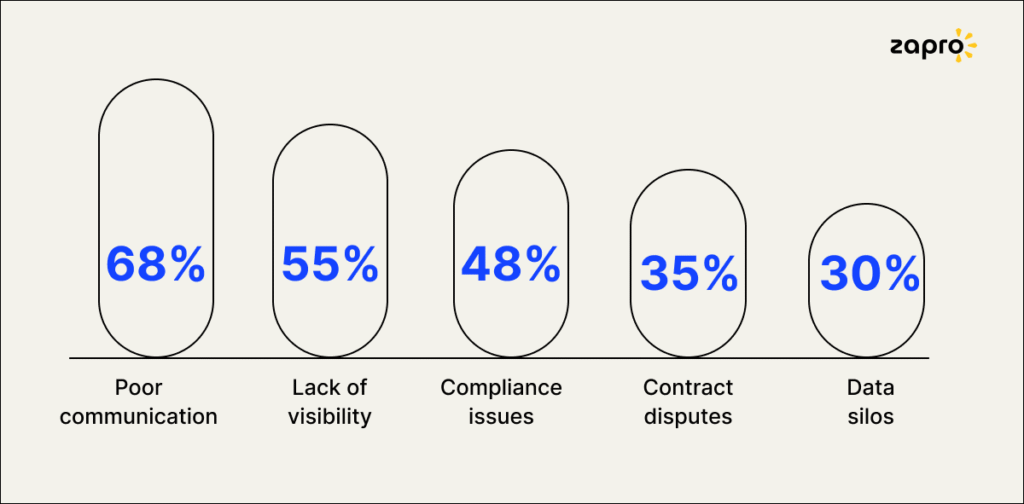
- Lack of documentation and version control
- Why it’s a problem: Relying on verbal agreements, outdated contracts, or scattered email trails can lead to disputes over pricing, timelines, and deliverables. In regulated industries, missing documentation can also trigger audit failures.
- Example: A mid-sized manufacturer lost a major client because their vendor failed to meet a safety standard. The gap? An outdated contract that didn’t reflect new regulatory changes.
- How to avoid it:
- Use a centralized contract repository (e.g., a contract management tool) with version tracking.
- Clearly define scope of work, KPIs, escalation procedures, and compliance obligations.
- Review and update agreements annually or when regulations change.
- Overreliance on a single vendor
- Why it’s a problem: Depending on one supplier for critical goods or services creates a single point of failure. A disruption — whether due to strikes, natural disasters, or bankruptcy — can halt operations.
- Example: During the 2021 global shipping crisis, companies with a single freight partner faced weeks-long delays, while diversified businesses kept shipments moving.
- How to avoid it:
- Maintain at least one qualified backup vendor for essential needs.
- Implement a dual-sourcing strategy for high-risk categories.
- Monitor vendor health through financial reports, market news, and risk assessments.
- Poor communication and unclear expectations
- Why it’s a problem: Misunderstandings over delivery dates, quality standards, or change requests often result in rework, delays, and strained relationships.
- Example: An IT services provider missed a critical product launch deadline because project milestones were only discussed verbally and never documented.
- How to avoid it:
- Set communication protocols during onboarding, including response times and preferred channels.
- Use collaborative tools (e.g., Slack, Microsoft Teams, project management software) to keep discussions transparent and traceable.
- Confirm agreements in writing after every significant discussion.
- Inadequate compliance and due diligence
- Why it’s a problem: Non-compliance can lead to fines, legal exposure, or damage to your brand. This risk is amplified in industries like healthcare, finance, or food manufacturing, where vendor compliance is heavily regulated.
- Example: A retail chain faced a $500k penalty after a supplier failed to comply with labor laws — even though the retailer wasn’t directly at fault.
- How to avoid it:
- Perform initial and ongoing compliance audits.
- Request and verify documentation such as ISO certifications, insurance coverage, and licenses.
- Use vendor risk management tools to automate compliance tracking and flag expirations.
| Pro tip: Build these safeguards into your vendor management process from day one rather than treating them as “fixes” later. This not only reduces risks but also positions your business as a professional, reliable partner, which in turn attracts higher-quality vendors. |
Tools and software to support your vendor management process
Managing vendors well takes more than spreadsheets and a few reminder emails. The right tools can help you track performance, manage contracts, and keep communication tight, without adding hours to your week.
- Vendor management systems (VMS)
- Platforms like Zapro make it easier to store vendor information, track contracts, and monitor performance in one place.
- Many come with built-in dashboards so you can see KPIs at a glance and spot issues before they become problems.
- Contract management tools
- Solutions like DocuSign CLM or ContractWorks help you create, store, and manage vendor contracts with proper version control.
- Automated alerts for contract renewals or expirations mean you won’t miss a renegotiation window.
- Performance tracking dashboards
- Tools like Power BI or Tableau let you visualize vendor data, delivery times, quality scores, cost trends, so patterns become obvious.
- They also make performance review meetings far more productive because everyone’s looking at the same data.
- Collaboration and communication platforms
- Slack, Microsoft Teams, or project management tools like Asana keep updates and decisions in one shared space.
- This cuts down on “lost” information buried in email threads and ensures accountability.
| Pro tip: If you’re just starting out, you don’t need to invest in everything at once. Even a basic VMS combined with a good communication tool can cover 80% of your vendor management needs and you can scale up as your vendor network grows. |
key takeaways
So, vendor management isn’t just about keeping a supplier list up to date, it’s about building relationships that help your business operate smoothly, reduce risk, and uncover new opportunities for efficiency.
The five steps we’ve covered include: identifying your needs, researching and selecting vendors, onboarding with clear expectations, monitoring performance, and optimizing or ending relationships.
We hope it gives you a clear framework you can adapt to your business size and industry. Get these right, and you’ll see better quality, fewer surprises, and stronger long-term partnerships.
But there are also challenges: even with a solid process, managing vendors across multiple tools and scattered communication channels can be overwhelming. That’s where a dedicated vendor management tool can make the difference.
Why Zapro could be the right choice for you
Think of Zapro as the “CRM for vendors.”
Just like businesses use Salesforce or HubSpot to manage customer relationships, Zapro helps you manage the full vendor lifecycle, not just transactions.
Instead of juggling 15+ separate tools for procurement, onboarding, compliance, and communication, you get one platform that does it all.
What sets Zapro Vendor Management Software apart:
- Brings procurement and relationship management together in a single system.
- Tracks every interaction, emails, calls, notes alongside transactions, so no context is lost when team members change.
- Includes built-in risk assessment and compliance tracking, replacing the need for extra third-party tools.
- Cuts vendor onboarding time in half and helps businesses save over 30% in related costs.
In short, Zapro doesn’t just help you manage vendors, it helps you work smarter with them, turning what’s often a fragmented process into a single, streamlined workflow.
If you want vendor management to be a strategic advantage, not a daily headache, it’s worth seeing what Zapro can do for your business.
Ready to turn vendor management into your competitive edge?
Don’t let scattered tools, missed updates, and compliance risks slow your business down. With Zapro, you can manage the entire vendor lifecycle, from onboarding to performance tracking, in one place, with complete visibility and zero guesswork.
Start building stronger, smarter vendor relationships today.
Build a streamlined vendor management process in just 5 steps.

Don’t miss our weekly updates
We’ll email you 1-3 times per week—and never share your information.

 Healthcare
Healthcare Financial Services
Financial Services Technology
Technology Venture Capitalist
Venture Capitalist Chief Procurement Officer
Chief Procurement Officer Chief Financial Officer
Chief Financial Officer
